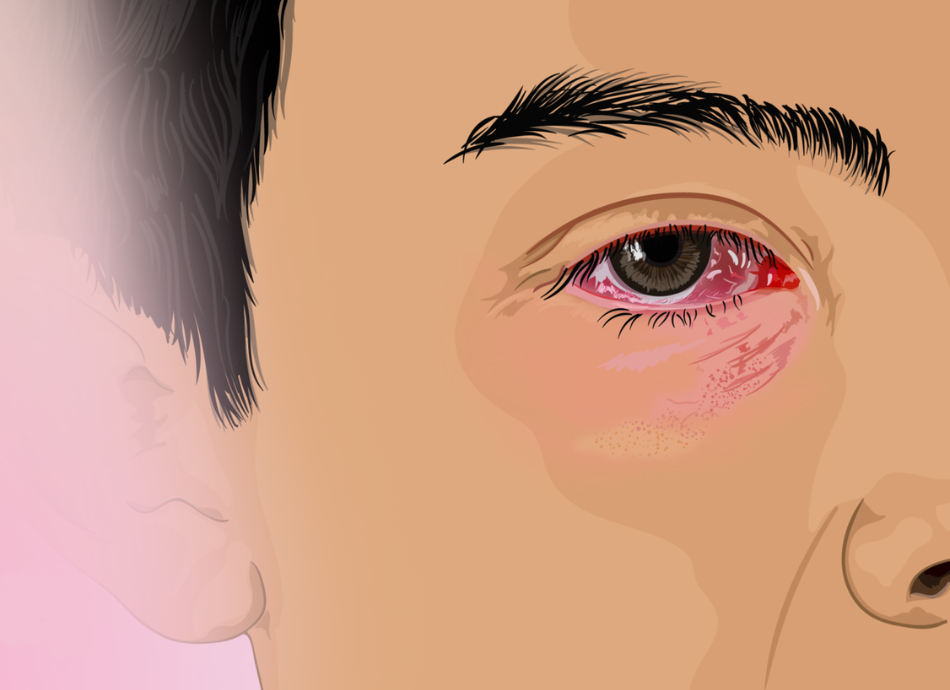Red eye
Key points about red eye
- A red eye is common and doesn't usually cause vision problems.
- A red eye is usually harmless although it can look serious.
- However, see your GP urgently if you have a red eye and blurry vision, eye pain, discharge from the eye, sensitivity to light, wear contact lens or have had an injury or trauma to your eye.
- Treatment of a red eye will be based on the condition you have.
- In most cases, a red eye will clear itself.

If you have a red eye:
- don't wear contact lens until your symptoms get better
- don't touch or rub your eyes.
|
See your doctor urgently if you have a red eye on one or both sides and any of the following: |
These symptoms suggest more serious causes and an urgent referral to an ophthalmologist (specialist eye doctor) may be needed. |
A red eye is caused by the expansion of blood vessels on the white part of your eye, known as the sclera. This can be caused by a number of conditions, including:
- blepharitis (inflammation of your eyelids)
- keratitis (inflammation of your cornea)
- conjunctivitis
- episcleritis
- scleritis
- glaucoma
- allergy
- infection
- eye injury
- subconjunctival haemorrhage (burst blood vessels)
- environmental irritants such as dust, smoke, fumes and chemicals
- eye drops
- dry eye.
You can see your doctor, optometrist or an ophthalmologist for a diagnosis. An optometrist is a trained healthcare provider who diagnoses and manages eye conditions. An ophthalmologist is a trained specialist doctor who manages eye conditions and performs eye surgery.
Your eye care provider will ask you about:
- whether you have a red eye on one side or both eyes
- how long you've had it
- any change to vision, discharge, pain or sensitivity to light
- any recent injury to your eye
- other symptoms such as fever, headache, nausea or a rash
- whether you wear contact lenses
- whether you have had any recent contact with someone with a red eye.
They will also examine your eye and perform tests if necessary to find out the cause. Read more about eye examination.
Treatment of a red eye will be based on the specific condition you have. For example, if you have conjunctivitis, the approach will be to treat your conjunctivitis, and may include antibiotic eye drops or ointments. Dry eye is treated with lubricating eye drops. Uveitis, episcleritis and scleritis are treated with anti-inflammatory eye drops. Subconjunctival haemorrhage will clear on its own.
Acute glaucoma is a potentially blinding condition. It requires urgent specialist input and treatment with medicine, laser and potentially surgery.
The following links provide further information about red eye. Be aware that websites from other countries may have information that differs from NZ recommendations.
Eye and vision problems(external link) Health New Zealand | Te Whatu Ora
Red eye(external link) NHS, UK, 2022
Subconjunctival haemorrhage(external link) PatientInfo, UK
References
- Red eye(external link) Auckland Regional HealthPathways, NZ, 2019
- Causes, complications and treatment of a red eye(external link) BPAC, NZ, 2013
- Red eye(external link) Patient Info, UK
- Evaluation of red eye(external link) BMJ Best Practice, UK
Red eye(external link) Auckland Regional HealthPathways, NZ, 2019
Causes, complications and treatment of a red eye(external link) BPAC, NZ, 2013
GP Eyes(external link), NZ (subscription required)
Red eye(external link) Eye Emergency Manual, Australia
Red eye(external link) Patient Info, UK
Evaluation of red eye(external link) BMJ Best Practice, UK
Credits: Healthify editorial team. Healthify is brought to you by Health Navigator Charitable Trust.
Reviewed by: Dr Divya Perumal, Ophthalmologist, Auckland
Last reviewed:
Page last updated:





